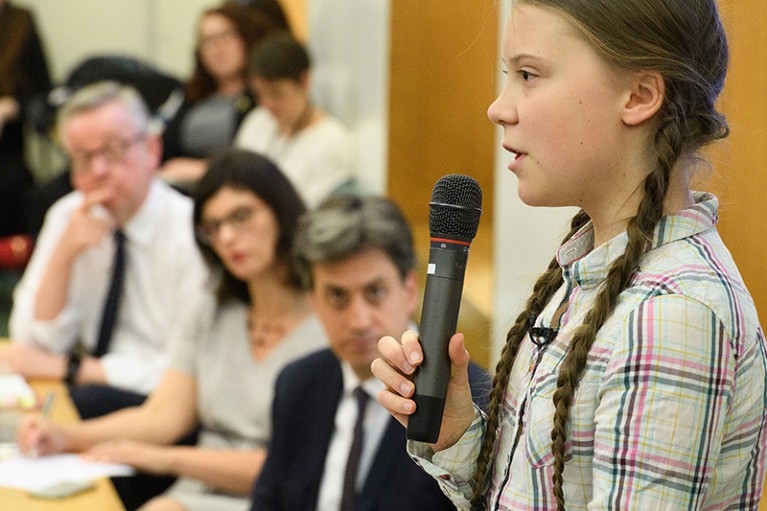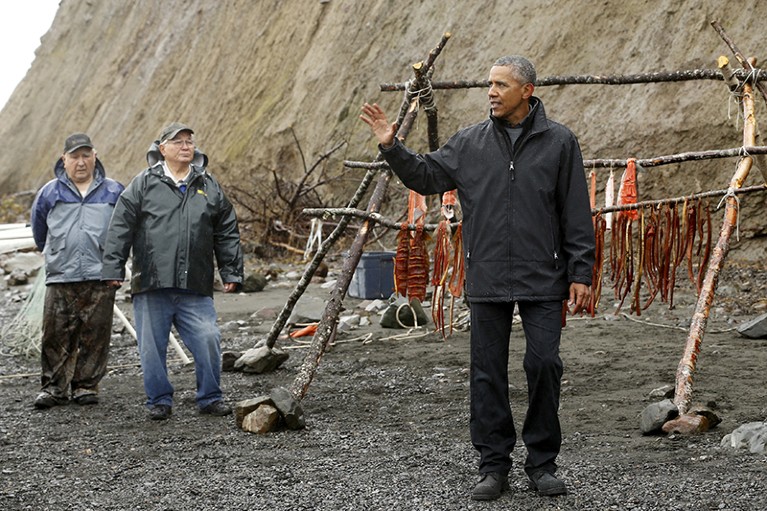
Greta Thunberg, an environmental activist from Sweden, speaks to politicians, the media and guests at the Houses of Parliament about the climate.Credit: Leon Neal/Getty
No matter how hard scientists work, our impact will almost always be limited to our immediate academic circles if our results never catch the attention of those who have the power to act on them. These people are often policymakers — local, state or central-government officials who write laws and regulations, craft budgets and govern communities.
But effective collaboration requires strong communication. The policy world can be tricky to navigate. Institutions can seem impenetrable, and decision-making is often opaque. Fortunately, simple strategies can help scientists to communicate effectively with policymakers.
Strategies for success
1. Know who you want to reach. Communicating with top-ranking officials — such as a state governor or a US senator — isn’t always the most effective way to spur change. Perhaps your research shows that overflowing storm drains are harming a nearby ecosystem. Such a local issue isn’t likely to rise high on the priority list of a senator, but does fall within the remit of your state environmental protection agency or county board of supervisors.
Your best partners might even be outside the government. Non-profit organizations, industry groups, advocacy organizations and private-sector companies don’t implement public policy as such, but certainly shape the debate. If you aren’t sure who you need to reach, ask around! Your university’s government-relations office and colleagues in your field might be able to point you in the right direction.
2. Have clear and actionable recommendations. Providing specific recommendations makes it easier for your audience to act. Pointing out that more chargers would support a growing demand for electric vehicles is a good start, but it’s even more helpful to explain exactly where and how many are needed. Specificity also prepares you to defend your recommendations by forcing you to think through the details.
Your suggestions should be feasible. Every government body is constrained by its mission and budget. Do your best to propose actions that fall within your target agency’s authority.
Careers collection: Funding science
Finally, remember that making recommendations is not the same as advocacy. One of the most valuable roles a scientist can have is laying out likely pros and cons of different policy options. Whereas an advocate typically exhorts a policymaker to ‘do Y’, a scientist can marshal the best available research to explain that, “If you do Y, chances are good that Z will result.”
3. Repackage your work. The peer-reviewed article is the currency of the scientific realm, but it’s not going to get you far in policy. A new audience demands a new format — one that is accessible and understandable.
Consider synthesizing your key findings and recommendations into a two-page policy brief that can be distributed easily in person or online. Repackaging your work into a publishable blog or opinion piece is also useful when you’re trying to reach a broader audience.

Former US president Barack Obama met with traditional fishers near Dillingham, Alaska, as part of a trip in 2015 to call attention to climate change.Credit: Jonathan Ernst/Reuters
4. Write well. Conversations and presentations are great ways to introduce a topic, but policymakers will want a written product to react to or to share with colleagues.
Organization, brevity and clarity are more important than wit or style when it comes to policy writing. State your key points first, then provide more explanation. Make sure there is a clear one-sentence takeaway in the very first paragraph. Add headings to separate sections, and use visual cues, such as bullets, to draw attention to key points. Define technical terms and spell out acronyms.
Above all, get someone else to read your work. Communicating your science to friends (especially non-experts) is the best way to get better at communicating your science to policymakers.
5. Pick your moment. Strategically selecting when to engage increases the chance that your idea will fall on receptive ears. Electoral and legislative calendars can help you to choose a good time. Meetings with elected officials tend to be much more effective towards the beginning of a term (when policy priorities are being set) than towards the end.
When in doubt, engage early. By the time a bill comes up for a vote or a rule is in its final stages, most policymakers will have been discussing it for months or longer. Even highly credible input will be unlikely to change minds. Look for newsletters and podcasts that can help you stay aware of when topics you care about are coming up for debate — and talk to legislators before this happens. Submit comments on draft rules and participate in stakeholder workshops when those are offered.
Current events can yield extra opportunities to advance your work. The value of news-generated ‘policy windows’ has been well documented. Stay aware of what’s going on in the world and link your research to it.
6. Sustain and amplify your engagement. Building support takes time and ongoing effort. Partnering with people and institutions who have an agenda similar to yours is a great way to strengthen your collective case.
It’s also crucial to follow up. Policy proposals evolve as they undergo review, debate and public comment. Once you’ve established a relationship with a key player, check in periodically to stay abreast of changes and update your recommendations accordingly. As a bonus, staying in touch demonstrates a level of investment that sets you apart from the crowd. This, in turn, increases the odds that a policymaker will reach out proactively with questions, making it even easier for you to stay in the loop as policies move forward.

 Help to shape policy with your science
Help to shape policy with your science






